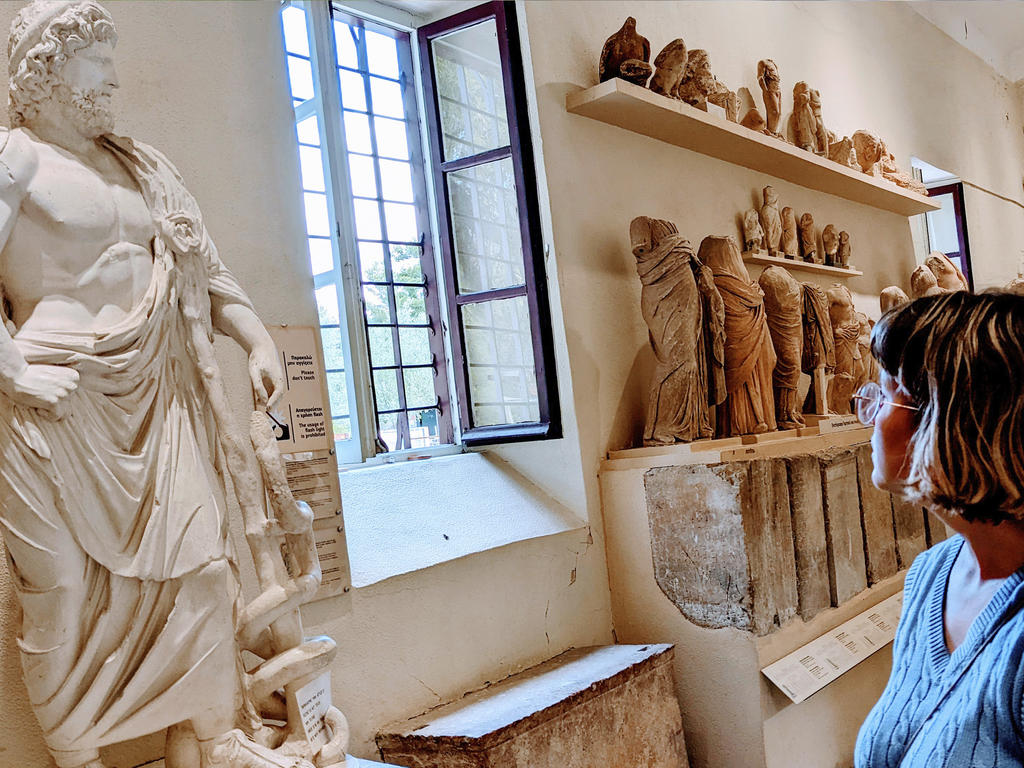The bay of Porto Rafti, Greece, punctuated by the islet of Raftis and the Koroni peninsula, was a bustling settlement during many prehistoric and historical periods, and provides potentially one of the best documentations of the still poorly understood late Bronze Age-early Iron Age transition. This past summer, Brittany Ashley ’23, Avery Comish ’24, Elizabeth Griffin ’23, and Isabella Brewer ’24, led by associate professor of art and art history Dr. Miriam Clinton, travelled to Porto Rafti to become part of the archaeological survey project known as BEARS--the Bays of East Attica Regional Survey, directed by Dr. Sarah Murray (University of Toronto) and Dr. Catherine Pratt (University of Western Ontario).
The 2022 season of BEARS focused on wrapping up previous seasons’ surveys of the area and mapping the ancient fortification wall on Koroni. The students rose as early as 6 a.m. to get ready for their day in the field, where they would join one of the four research groups either sailing to the Raftis Island, going into the fields of Porto Rafti, hiking up Mount Koroni, or washing and analyzing the previous day’s finds at the local museum.
“What I found most interesting is how much you find just looking at the ground in Greece,” says Ashley. “We would be walking in a regular farmer's field, four or five of us in our own specific lines, 10 meters apart, and at your feet would be chunks of obsidian or sherds of pottery—artifacts thousands of years old right there in front of you.”

Brewer shared Ashley’s experience. “I had expected the stereotypical image of archaeologists digging in the ground to find the smallest sherd of pottery, but we never had to dig and could usually pick up an artifact sitting on top of the dirt,” she says. “This only intensified the feeling that what we were doing was incredibly important, as more and more land in Greece is being developed for commercial and residential use and these artifacts can only be saved from being completely lost by carrying out surveys like BEARS.”
Besides essential analog tools such as plastic bags to collect potential artifacts and pencils and papers to record data, the students also mastered the dGPS system—an advanced digital technology using satellite navigation—to plot out architectural images. The students learned how to use these tools in the field through hands-on experience over the four weeks of the program.
The students joined the program having different interests and levels of experience. Brewer had nurtured an interest in archaeology since high school, but the past summer was the first time the art history major and archaeology minor participated in fieldwork. Her time with BEARS was so impactful that she will accompany Clinton back to Porto Rafti next summer as a part of the archeology team. She also began the Turley Fellowship this Fall Semester, assisting Clinton with research on the Mouliana tombs in Crete, which will be presented at the Archaeological Institute of America’s 2023 annual meeting.
The 2022 Greece Maymester was also Ashley’s first time on an archaeological survey. While the art history and English double major does not share a professional interest in archaeology, she believes the experience will inform her future studies as she pursues a master’s degree in art history.
Beyond fieldwork, the students attended evening classes on archaeological methods, theory, and the Greek language with Clinton, community building activities with the BEARS team, and weekend trips to different museums and sites around Greece. “By the end of it, we had not only been living in a foreign country for a month on our own, but we were also comfortable there,” says Ashley.
At the end of the four weeks, through museum visits, observations of the behind-the-scenes process of preparing artifacts for study, and interactions with graduate student members on the BEARS team, Ashley narrowed down aspects of art history—theory and museum design—that she is most interested in.
Brewer, on the other hand, was motivated by her overseas experience to further her commitment to archaeology. She is now considering pursuing a career in archaeology after graduation and has worked to further integrate the subject into her art history degree. “Before attending the Maymester, I did not think of archaeology as a possible career path for myself,” she says. “Being a part of BEARS not only helped me realize that I had a deeper interest in archaeology than I previously thought, but it also gave me the opportunity to prove to myself that I was capable of meeting the challenges of the field.”

